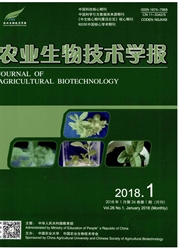

 中文摘要:
中文摘要:
水稻矮缩病毒(Rice dwarf virus,RDV)主要由介体昆虫黑尾叶蝉(Nephotettix cincticeps)以持久增殖型方式传播。在RDV侵染介体黑尾叶蝉培养细胞时,病毒编码的非结构蛋白Pns11参与形成病毒原质,但Pns11的具体功能尚不知晓。本研究应用RNA干扰(RNA interference,RNAi)技术,将体外合成靶向Pns11基因的ds RNA转染黑尾叶蝉培养细胞,可显著降低Pns11的表达,并抑制病毒的积累和侵染。用显微注射技术将体外合成靶向Pns11基因的ds RNA导入到黑尾叶蝉,可显著抑制病毒在昆虫体内的侵染和扩散,最终降低介体传毒效率。结果表明,RDV Pns11是病毒在介体昆虫体内侵染和复制所必需的,是病毒复制的关键因子,可作为阻断病毒在介体内的复制和传播提供有效靶点。
 英文摘要:
英文摘要:
Rice dwarf virus(RDV) is mainly transmitted by leafhopper(Nephotettix cincticeps) in a persistentpropagative manner. The genome of RDV consists of 12 ds RNA segments, encoding at least 7 structural proteins(P1, P2, P3, P5, P7, P8 and P9) and 5 non-structural proteins(Pns4, Pns6, Pns10, Pns11 and Pns12).Pns11 of RDV is known to be a gene silencing suppressor in plant, and participates in the formation of viroplasm for viral replication and assembly of progeny virions in the cultural cells of N. cincticeps. However,the definite function of Pns11 in viroplasm in insect vector is still unknown yet. In the present study, RNA interference(RNAi) was firstly applied via delivering the synthesized ds RNAs in vitro from Pns11 gene into cultural cells of N. cincticeps. Immuno- fluorescence assay showed that when Pns11 was knocked down, the antigens of Pns11 were significantly reduced, and RDV was restricted within 1-2 cultural cells. The infectivity evaluated with the fluorescent antibody focus counting method showed the level of the viral infection decreased about 5 times. These results indicated that RNAi targeting on Pns11 gene significantly reduced the expression of Pns11, leading the RDV accumulation and infection, was blocked in the cultural cells. Thus,Pns11 was assumed to associate with viral replication. Then, microinjection of ds RNAs from Pns11 into the body of N. cincticeps was performed. q RT- PCR test showed the knockdown of Pns11 significantly decreasedthe viruliferous rate of insect more than 60%. And the RNAi effect steadily lasted for more than 12 d, which was nearly a circulative transmission period. q RT- PCR assay showed that knockdown of Pns11 caused more than 80% reduction in the relative expression levels of P8 and Pns11 genes. It was suggested that RNAi targeting on Pns11 gene inhibited the viral accumulation in body of N. cincticeps, and decreased the number of viruliferous insect. Immuno- fluorescence assay displayed that at 6 d after microinjection, RDV and Pns11 were detected
 同期刊论文项目
同期刊论文项目
 同项目期刊论文
同项目期刊论文
 Nonstructural protein Pns4 of rice dwarf virus is essential for viral infection in its insect vector
Nonstructural protein Pns4 of rice dwarf virus is essential for viral infection in its insect vector Infection route of rice grassy stunt virus, a tenuivirus, in the body of its brown planthopper vecto
Infection route of rice grassy stunt virus, a tenuivirus, in the body of its brown planthopper vecto 期刊信息
期刊信息
